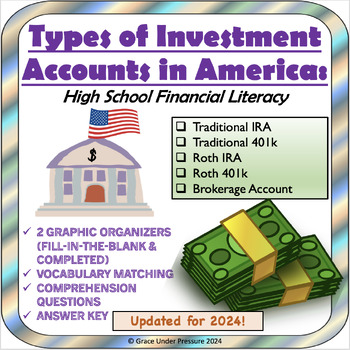Types of Investment Accounts (USA): 401k, Roth IRA, Traditional IRA, Brokerage
Grace Under Pressure
325 Followers
Grade Levels
9th - 12th
Subjects
Resource Type
Standards
CCSSMP4
Formats Included
- PDF
- Easel Activity
Pages
6 pages
Grace Under Pressure
325 Followers
Easel Activity Included
This resource includes a ready-to-use interactive activity students can complete on any device. Easel by TPT is free to use! Learn more.
Description
This high school financial literacy lesson covers all the basics of American investment accounts. Teach your students the tax benefits when investing, growing, and selling in each of the 5 accounts. Introduce ideas such as income tax, capital gains tax, and required minimum distributions.
***Updated in 2024 to include new contribution limits***
Clear and simple information about the rules and benefits of each of these 5 accounts is included.
- Traditional Individual Retirement Account
- Traditional 401k
- Roth 401k
- Roth Individual Retirement Account
- Brokerage Account
This ready-to-go package includes the following:
- 2 Graphic Organizers (fill-in-the-blank & completed)
- Vocabulary Matching
- Comprehension Questions
- Answer Key
Total Pages
6 pages
Answer Key
Included
Teaching Duration
90 minutes
Report this resource to TPT
Reported resources will be reviewed by our team. Report this resource to let us know if this resource violates TPT’s content guidelines.
Standards
to see state-specific standards (only available in the US).
CCSSMP4
Model with mathematics. Mathematically proficient students can apply the mathematics they know to solve problems arising in everyday life, society, and the workplace. In early grades, this might be as simple as writing an addition equation to describe a situation. In middle grades, a student might apply proportional reasoning to plan a school event or analyze a problem in the community. By high school, a student might use geometry to solve a design problem or use a function to describe how one quantity of interest depends on another. Mathematically proficient students who can apply what they know are comfortable making assumptions and approximations to simplify a complicated situation, realizing that these may need revision later. They are able to identify important quantities in a practical situation and map their relationships using such tools as diagrams, two-way tables, graphs, flowcharts and formulas. They can analyze those relationships mathematically to draw conclusions. They routinely interpret their mathematical results in the context of the situation and reflect on whether the results make sense, possibly improving the model if it has not served its purpose.






